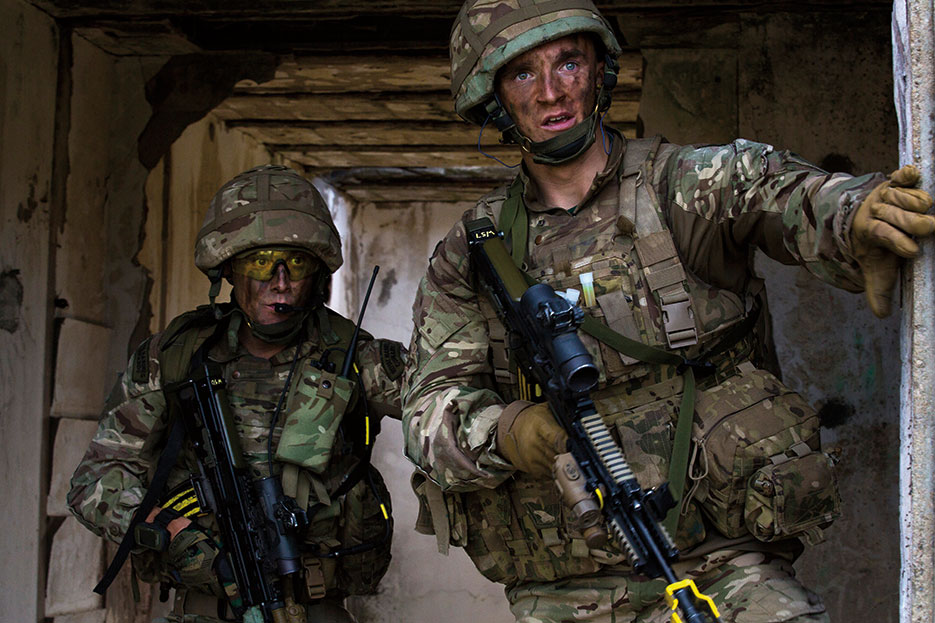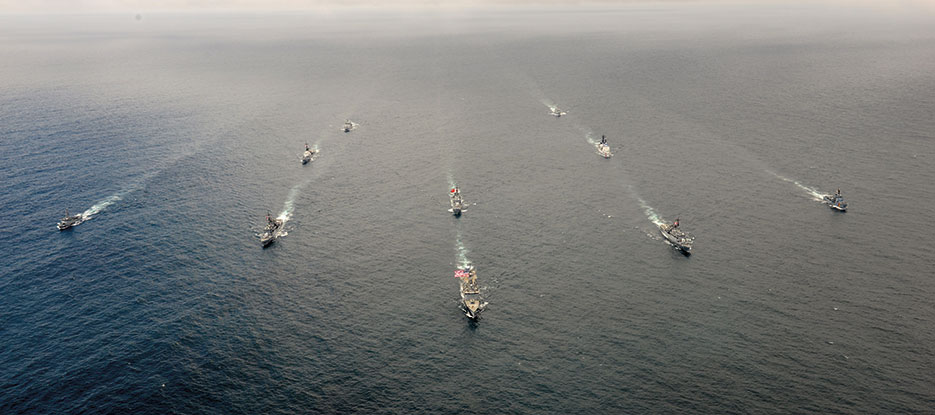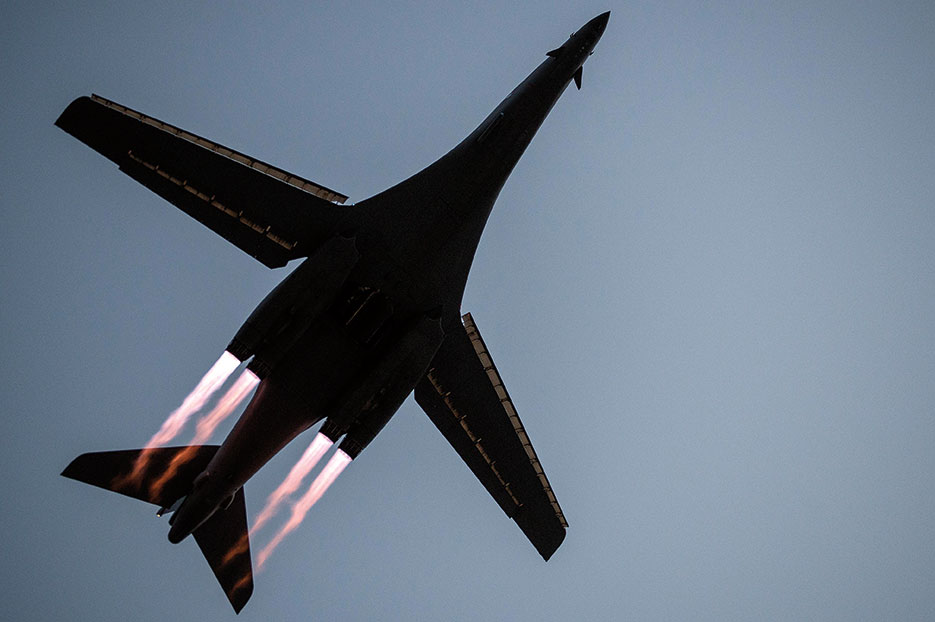Colonel Michelle L. Pryor, USAF, is the Joint Staff J3 Chief of Multinational Operations Division and Multinational Interoperability Council Executive Secretariat. Lieutenant Colonel Thomas Labouche, French Army (Foreign Legion), is a Liaison Officer to the Joint Staff J3 Multinational Interoperability Council. Lieutenant Colonel Mario Wilke, German Luftwaffe, is a Liaison Officer to the Joint Staff J3 Multinational Interoperability Council. Charles C. Pattillo, Jr., is the Deputy Chief for the Multinational Operations Division and Multinational Interoperability Council Executive Secretariat.
Throughout history, coalitions have played an important role in military operations. In today’s globalized world, nations are becoming even more likely to take part in an operation as part of an alliance or coalition, rather than engaging in operations on their own.1 Whether the operation involves an established alliance or an ad hoc coalition, interoperability between multinational forces is imperative to achieving mission success. To be successful in the anticipated complex and shifting operating environment, coalition forces must identify and address potential strategic and operational challenges and interoperability concerns well in advance. This requires an investment in areas of common doctrine development, coalition planning, exercises, and experimentation. Early identification of the potential challenges can improve the speed and quality of decisionmaking and enhance unity of effort within a coalition. The Multinational Interoperability Council (MIC), led by senior operators of the member nations, focuses on understanding and addressing contemporary strategic and operational challenges and risks.

U.S. Marines with Special-Purpose Marine Air-Ground Task Force-Crisis Response–Africa and Royal Marines with 45 Commando clear rooms during combined operation part of exercise Blue Raptor in Frasselli, France, November 20, 2015 (U.S. Marine Corps/Keonaona C. Paulo)
Focus on Coalition Operations
Today, many nations are working together in various coalition efforts throughout the world. Moreover, support for coalition operations within peacekeeping, humanitarian aid, and military conflict continues to grow. From a doctrinal standpoint, the U.S. National Security Strategy emphasizes the importance of engaging with our allies and partners as well as other state partners, nonstate and private actors, and international institutions.2 This engagement helps advance both political and military objectives. Key advantages to operating as a coalition include an increased level of acceptability and legitimacy to military action, burden-sharing of operational costs, shared resources, shared expertise, and niche capabilities.3 Merging the capabilities of different military forces adds depth through strength in numbers and breadth through additional capabilities, as well as providing access to national and/or regional infrastructure, logistics, and information.4
While many advantages exist for multinational and coalition operations, these operations gather diverse entities whose national interests, military capabilities, definitions of success, and risk tolerance may differ. Additionally, multinational diversity may present challenges through capability gaps in standardization, doctrine, rules of engagement, information-sharing capabilities, training, and command and control.5 Despite these complexities, multinational and coalition operations are increasingly preferred not only because of individual nations’ resource constraints but also because they reinforce legitimacy to operations in an international setting.
The future operating environment for coalitions will be even more volatile, uncertain, complex, and dynamic, and we must continue to adapt to these changes.6 To respond to these threats, coalition members must have an awareness, understanding, and appreciation of the other participating nations and organizations capabilities within the context of multinational/coalition operations. By understanding each other’s capabilities and having an awareness of identified obstacles to overcome, coalition members can work together more effectively and maximize the benefits of coalition operations. This is particularly true in the case of an ad hoc coalition where members may not have trained together extensively during peacetime. By fostering a coalition operating culture, the MIC intends to identify and address potential operational challenges now rather than waiting until a crisis.
The Multinational Interoperability Council
The MIC provides a unique, senior operator–led multinational forum to understand and address contemporary strategic and operational challenges and risks. The MIC’s objectives are to build relationships to enhance mutual trust and understanding of national perspectives and to influence the development of operational practices to enable more effective coalition operations.
The MIC originated from an October 1996 multinational symposium entitled “C3I for the Coalition Task Force.” Ministries and departments of defense participants from Australia, Canada, France, Germany, the United Kingdom, and the United States recommended the establishment of an operator-led council to provide oversight of coalition interoperability and assist in the implementation of approved actions. The council’s inaugural meeting was in October 1999, and in May 2005 Italy joined the MIC as the seventh member nation.
The MIC’s purpose continues to evolve with early emphasis placed on identifying interoperability issues and facilitating the exchange of relevant information across national boundaries to support multinational/coalition operations. Recently, the MIC expanded its focus beyond interoperability to embrace a more inclusive look at challenges within contemporary operations. The MIC also retained its focus to:
- facilitate the formation of coalitions by identifying and mitigating strategic inhibitors
- set the conditions for stronger coalitions and enhanced interoperability for future operations
- promote national actions to resolve issues related to coalition operations and interoperability
- provide a range of accessible information to enhance coalition operations
- collaborate with other multinational interoperability fora.
To be a MIC member, a nation must demonstrate the competence and capability to lead a coalition and multinational operation, evidenced by leadership and involvement in recent coalition operations; the willingness to commit resources to leading and/or supporting coalition operations; and the willingness to commit sufficient personnel and resources to participate in all MIC meetings. The MIC aims to remain responsive, flexible, and credible in understanding and addressing contemporary strategic and operational challenges and risks. To keep this quality, the MIC needs to have a finite number of member nations.7
The MIC also maintains a close working relationship with the North Atlantic Treaty Organization (NATO) Allied Command Transformation, NATO Allied Command Operations, and European Union Military Staff, as well as New Zealand. Representatives from these organizations or nation may attend MIC meetings through an invitation as an observer when the MIC considers their participation as being mutually beneficial in supporting a specific topic or area of interest.
The MIC principals are senior flag officer/general officer operators from each MIC nation empowered to discuss national perspectives and address operational challenges and risks across the contemporary operating environment. The U.S. MIC principal is the Joint Staff Director for Operations. The MIC principals meet semi-annually and are responsible for defining and articulating the MIC’s strategic direction and for providing guidance and directing appropriate actions to the action officers (AOs) directly or through the steering group (SG).
The SG is composed of O6/NATO OF5 representatives from each MIC member nation. They are responsible for coordinating and executing tasks assigned by the MIC principals and providing guidance, oversight, and direction to the AOs to accomplish the MIC’s work as directed and approved by the MIC principals. Additionally, MIC AOs act as national points of contact who coordinate the respective national analysis of contemporary operational risks and challenges as directed by the MIC principals and identify solutions and/or prepare recommendations for approval by the principals. When addressing an operational challenge, the goal is to attain an agreed-upon position by seven nations when possible. If consensus is not possible, the AOs identify any differing national positions and caveats to establish a baseline of similarities and differences of national positions. This process assists in developing a mutual awareness, understanding, and appreciation among the participating member nations.
The MIC executive secretariat (ES) staff is responsible for managing and coordinating the day-to-day business activities for the MIC and serves as the central point of contact for the MIC principals, SG, and AOs. As a unique permanent structure, the MIC ES is the primary contact for outreach activities and external engagement, coordination, and communication with non-MIC nations, organizations, and other multinational organizations. Two U.S. members along with two foreign liaison officers from other MIC member nations (currently from France and Germany) serve as the MIC ES staff.

Marines attempt to break through wall of Bulgarian and Serbian soldiers during riot control course of Platinum Wolf 15 at South Base, Serbia, November 19, 2015 (U.S. Marine Corps/Derrick Irions)
Products
While the MIC provides some of its project results directly to operators, national staffs, or other multinational organizations, many project results are located in the main product that captures the MIC’s work: the Coalition Building Guide (CBG), whose purpose is to assist MIC member nations, as a coalitions’ lead nation, and their potential partners to work more effectively together in a coalition operation. It aims to offer guidance to a lead nation, a designated coalition force commander and the national staffs or coalition task force staffs in building and sustaining effective coalitions.8 The CBG also attempts to provide a common framework of reference by identifying some of the essential factors associated with the coalition-building process to inform participating nations as to what to expect. The CBG does not constitute official policy or doctrine, nor does it represent a definitive staff planning or military decisionmaking guide. The MIC acknowledges NATO joint doctrine, unless otherwise specifically directed, as the default doctrine for planning and conducting coalition operations. Additionally, U.S. Joint Publication 3-16, Multinational Operations, captures information from the CBG with regard to coalition planning.
The CBG consists of three volumes. Volume I, Military Strategic Overview, covers the fundamentals of coalition building.9 Volume II, Strategic Design and Planning, covers the principles of planning coalition operations at the strategic level by addressing the broad lines of recommended organization, processes, and tools for a coalition to ensure more robust cohesiveness within the coalition at the strategic military level.10 Volume III is a compilation of separate MIC documents that cover key coalition challenges and risks to consider when building and sustaining a coalition. The volume’s separate and distinct chapters allow planners and staffs to select an individual section for quick reference. Chapter topics include but are not limited to the future coalition operating environment, humanitarian/disaster response, communication and information systems, strategic communication, and cyber defense.11

Peruvian, Mexican, Chilean, Colombian, and U.S. ships transit in formation as part of Unitas 55-14 in Pacific Ocean, September 16, 2014 (DOD/Adam Henderson)
A Way Ahead
Historically, major focus areas for the MIC included using a comprehensive approach, developing civil-military cooperation within coalitions, and emphasizing cultural awareness and competence. These areas will continue to play a dominant role in the success of coalition operations. As we move toward the future, areas such as expanding information-sharing, preparing for ad hoc coalitions (rather than only previously established coalitions), and increasing collaboration between multinational organizations will also play an important role in coalition successes.
Comprehensive Approach. Interoperability extends to integrating the political, security, development, rule of law, human rights, and humanitarian dimensions of international missions. This integration describes a comprehensive or whole-of-government approach, exploiting cohesion and realizing coalition synergies.12 The comprehensive response must be based on a shared understanding of the problem and universal commitment to resolve it. A comprehensive approach centers on the ability of all coalition military forces and other government departments, nongovernmental organizations, and international agencies to plan, communicate, and operate in a collaborative environment throughout all phases of an operation.
Civil-Military Cooperation. Civil-military relationships are important to the success of a comprehensive approach and overall multinational operation.13 The outcomes of recent and current operations clearly demonstrate that civil-military relationships must be considered to understand the compatible, supportive, and competing interests of each represented element, as well as how best to coordinate, deconflict, and interface the military forces with the local population, other governmental agencies, and the international humanitarian community. Effective relationships and coordination with the wide range of civilian organizations, local populations, governments, and military forces are essential. These activities require resources, arrangements, and activities in support of the mission, which fosters liaison, cooperation, and coordination with entities outside of the multinational force.
Coalition commanders and their staffs must have an awareness, understanding, and appreciation of how military operations are typically embedded in a larger context of civil-military interaction. It is imperative to inform potential civilian partners on the vision and views of militaries concerning such a civil-military framework and a method to crisis prevention, crisis management, and postconflict activities. The incentive for a successful civil-military effort is twofold: first, motivation to avoid duplication of efforts including spending unnecessary energy and resources, and second, recognition that the goals of military and civilian organizations are most often co-dependent even though their realization may not always be simultaneous.
Cultural Awareness and Competence. Coalition operations will take place in complex operational environments with a multitude of actors, where opposing forces and the population are intermingled in a way that it is hard to distinguish among the different stakeholders. Coalitions by themselves could be more challenging due to the number of nationalities they are likely to encompass.
To operate in such an environment requires the support and trust of other friendly, neutral, or other groups in the surrounding area or from other governmental or nongovernmental organizations to avoid inappropriate behavior and ideally to gain the trust of the people and to understand their claims and their needs.
Cultural aspects or cross-cultural differences, their knowledge and application, and the evaluation and synthesis of these subjects will remain relevant in current and future coalition operations not only when operating in close proximity to foreign populations but also in all kinds of operations where the military might be involved.14
Information-Sharing. Information-sharing is a recurring lesson identified from many recent operations and therefore key to the MIC’s goal of delivering better, more efficient military capabilities that are coordinated around the needs of the task.15 Information-sharing is essential to enable early planning, intervention, and preventative work resulting in effective and timely responses to crises, while also providing for the collective security and well being of a coalition. As nations move toward increased partnership and integrated services, professional and confident information-sharing is becoming more important to delivering the benefits of these arrangements. Information-sharing reduces duplication of effort while maximizing strengths and capabilities of responding forces; it should be necessary, proportionate, relevant, accurate, timely, and secure. A proper information exchange environment enables rapid transfer of information to appropriately designated receivers, while rigorously protecting information from unauthorized disclosure and release.
Focus on Ad Hoc Coalitions. Today’s rapidly changing global landscape has given rise to the development of more ad hoc coalitions consisting of groups of nations and or organizations working together outside of previously established alliances. In the future, greater consideration needs to be given to developing procedures for quickly establishing an ad hoc coalition and determining interoperability concerns for such situations. This will continue to be a challenge as national involvement within ad hoc coalitions will vary from one coalition operation to the next.

B-1B Lancer takes off from strategic coalition air base Al Udeid Air Base, Qatar, to conduct combat operations April 8, 2015 (U.S. Air Force/James Richardson)
Continued Collaboration. We must continue to expand our knowledge of other multinational organizations that are dedicated to solving multinational interoperability challenges to work together toward a shared solution for the future, capitalize on mutually beneficial lessons learned, and eliminate duplicative work. The MIC maintains coordination with various multinational groups including but not limited to the Washington, DC–based Multifora, which is comprised of nine separate organizations addressing various aspects of multinational interoperability, multinational planning augmentation team, coalition interoperability assurance and validation, multinational information operations experimentation, and the multinational capabilities development campaign.
Coalition operations continue to shape and become the norm for the military’s involvement in activities and engagements around the globe. Thus, it is essential to gain an awareness, understanding, and appreciation of each potential partner’s capabilities, limitations, and culture in advance of operations to enhance the success of future multinational coalition operations. Therefore, mutual trust attained through relationships during peacetime is likely to foster more efficient interaction when building and sustaining a coalition operation. Beyond common doctrine, similar equipment and shared interests, the human factor plays a vital role in effective partnerships and remains an essential element in coalition success. In this regard, the MIC offers a unique opportunity for senior operators to build essential relationships and understand and address coalition operations challenges and risks from respective national perspectives, ultimately helping to shape more effective coalition operations. JFQ
Notes
1 Multinational Interoperability Council (MIC), Coalition Building Guide, Volume I: Military Strategic Overview (Washington, DC: The Joint Staff, 2015).
2 National Security Strategy (Washington, DC: The White House, 2015).
3 MIC, Coalition Building Guide, Volume III: Future Coalition Operating Environment (Washington, DC: The Joint Staff, 2012).
4 MIC, Coalition Building Guide, Volume I.
5 MIC, Coalition Building Guide, Volume III (2012).
6 Ibid.
7 MIC, Membership Policies and Procedures (Washington, DC: The Joint Staff, 2015).
8 MIC, Coalition Building Guide, Volume I.
9 Ibid.
10 MIC, Coalition Building Guide, Volume II: Strategic Design and Planning (Washington, DC: The Joint Staff, 2015).
11 Information on these MIC documents, as well as other MIC products, is available at <https://community.apan.org/wg/mic>.
12 MIC, Coalition Building Guide, Volume I.
13 MIC, Coalition Building Guide, Volume III: The Military Contribution to Stabilization Operations (Washington, DC: The Joint Staff, 2013).
14 MIC, Coalition Building Guide, Volume III: Cross Cultural Awareness and Competence (Washington, DC: The Joint Staff, 2015).
15 MIC, Coalition Building Guide, Volume III (2012).